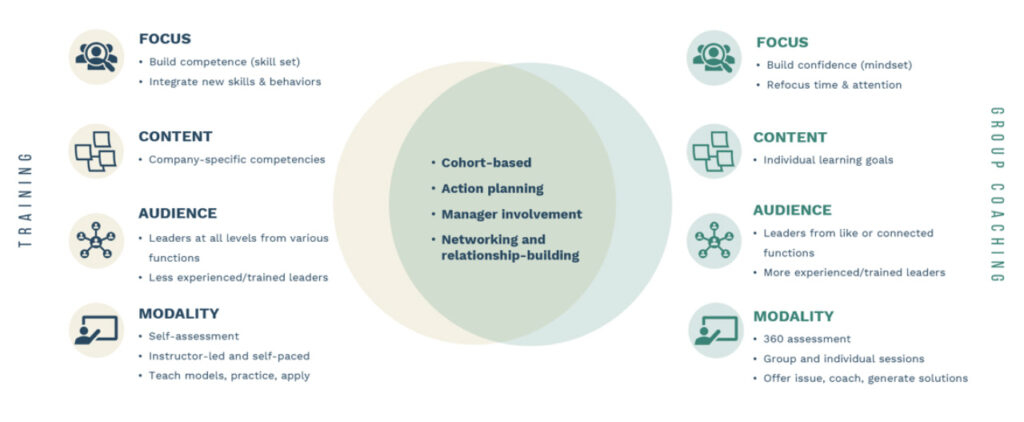Mindful of the need for results amid a challenged workforce and tight budgets, learning and development professionals regularly seek to balance innovation with efficiency and recognized learning strategies.
Over the last decade, leadership coaching has proven to be a tried-and-true approach to learning and development. The personalized nature of a coaching engagement gives leaders an opportunity to better understand themselves while building new skills and more productive habits with the help of a trusted and experienced thinking partner.
Similarly, instructor-led training remains the predominant method for most organizations to provide leadership and management development. Done well, a facilitator combines the presentation of new information and best practices with active opportunities to discover, collaborate, practice, and plan for the application of behavior change back on the job by teaching new skills and increasing knowledge in a cohort-based environment.
While rooted in both modalities, group coaching is a significantly different approach to leadership development.
How is it different?
The foundational principle underpinning training is that the instructor has new knowledge the learner needs. The training session is about imparting that information in a purposeful way over a set amount of time. With group coaching, the premise is that the participants already have the knowledge they need but can benefit from a refresher to reframe and reuse this knowledge in support of today’s work challenges. The coach or facilitator is there to harness that knowledge and help the group process it for application back on the job.
Training events usually begin with raising awareness about why the training topic is importance and how it is relevant to the participants. The trainer is typically tasked with teaching a model for best practice behavior or thinking. They provide structured opportunities to practice while helping learners determine how to apply what they are learning to their daily work. In group coaching, participants bring a current challenge to the session. They then use a specific process to explore the issue and gain insight from their fellow participants. By the end of the session, they are able to commit to new and healthier actions.
The graphic below summarizes the ways training and group coaching overlap and how they differ in areas of focus, content, audience, and modality.

If you are interested in creating a group coaching program in your organization, here are some guidelines to keep in mind.
- There is no “one size fits all” program design. Depending on your audience and their learning needs, you can have a program that ranges in length from 12 weeks to 12 months. You can include only group sessions or layer in some individual coaching sessions. You might also choose to train participants on key concepts between the group coaching sessions. For example, we teach the six elements of a leadership mindset as part of one of our successful group coaching programs.
- When choosing participants for the group, ensure you select experienced leaders who have previously attended training programs, yet currently need to refocus their time and attention.
- Make sure the participants in each cohort are willing and able to serve as peer coaches to each other. Trust among the participants should already be high or have strong potential to develop during the program. We begin our group coaching programs by teaching a four-hour workshop on peer coaching skills. This sets the program up for success.
Ready to learn more? The resources listed below provide you with additional insights, program details, examples, and a program design checklist.
New e-Book
Group Coaching: A New Application for Leadership Coaching
HRCI Alchemizing HR Webinar
“New Applications for Leadership Coaching (Part Two): Group Coaching for Retention”
As always, I appreciate hearing your ideas, insights, and comments.
Please reach out if you’d like to discuss the best way to provide leadership development, team development, and coaching to support your valuable leaders.


